#junior high school 1978
Text
#junior high school#junior high school 1978#junior high school (1978)#filmedit#video#videos#bad movies#bad movie
1 note
·
View note
Text

Minnie Julia Riperton Rudolph (November 8, 1947 – July 12, 1979) was an American singer-songwriter best known for her 1975 single "Lovin' You" and her four octave D3 to F♯7 coloratura soprano range. She is also widely known for her use of the whistle register and has been referred to by the media as the "Queen of the Whistle Register."
Minnie Riperton grew up in Chicago's Bronzeville neighborhood on the South Side. As a child, she studied music, drama and dance at Chicago's Lincoln Center. The youngest of eight children in a musical family, she embraced the arts early. Although she began with ballet and modern dance, her parents recognized her vocal and musical abilities and encouraged her to pursue music and voice. At Chicago's Abraham Lincoln Center, she received operatic vocal training from Marion Jeffery. She practiced breathing and phrasing, with particular emphasis on diction. Jeffery also trained Riperton to use her full range. While studying under Jeffery, she sang operettas and show tunes, in preparation for a career in opera. Jeffery was so convinced of her pupil's abilities that she strongly pushed her to further study the classics at Chicago's Junior Lyric Opera.
The young Riperton was, however, becoming interested in soul, rhythm and blues, and rock. In her teen years, she sang lead vocals for the Chicago-based girl group the Gems. Eventually the group became a session group known as Studio Three and it was during this period that they provided the backing vocals on the classic 1965 Fontella Bass hit "Rescue Me".
After graduating from Hyde Park High School (now Hyde Park Academy High School), she enrolled at Loop College and became a member of Zeta Phi Beta sorority. She dropped out of college to pursue her music career.
Her early affiliation with the legendary Chicago-based Chess Records afforded her the opportunity to sing backup for various established artists such as Etta James, Fontella Bass, Ramsey Lewis, Bo Diddley, Chuck Berry and Muddy Waters. While at Chess, Riperton also sang lead for the experimental rock/soul group Rotary Connection, from 1967 to 1971.
On April 5, 1975, Riperton reached the apex of her career with her No. 1 single "Lovin' You". The single was the last release from her 1974 gold album titled Perfect Angel. Riperton's third album, Adventures in Paradise was released in 1975. Despite the R&B hit "Inside My Love", some radio stations refused to play "Inside My Love" due to the lyrics.
Her fourth album for Epic Records, titled Stay in Love (1977), featured another collaboration with Stevie Wonder in the funky disco tune "Stick Together".
In 1978, Richard Rudolph and Riperton's attorney Mike Rosenfeld orchestrated a move to Capitol Records for Riperton and her CBS Records catalog. In April 1979, Riperton released her fifth and final album, Minnie. "Memory Lane" was a hit from the album.
Riperton provided backing vocals on Stevie Wonder's songs "Creepin'" from 1974's Fulfillingness' First Finale and "Ordinary Pain" from 1976's Songs in the Key of Life. In 1977, she lent her vocal abilities to a track named "Yesterday and Karma", on Osamu Kitajima's album, Osamu.
In January 1976, Riperton was diagnosed with breast cancer and, in April, she underwent a radical mastectomy. By the time of diagnosis, the cancer had metastasized and she was given about six months to live. Despite the grim prognosis, she continued recording and touring. She was one of the first celebrities to go public with her breast cancer diagnosis but did not disclose she was terminally ill.
In 1977, she became a spokesperson for the American Cancer Society. In 1978, she received the American Cancer Society's Courage Award, which was presented to her at the White House by President Jimmy Carter.
Riperton died of cancer on July 12, 1979 at the age 31.
During the 1990s, Riperton's music was sampled by many rap and hip-hop artists, including Tupac Shakur, Dr. Dre, A Tribe Called Quest, Blumentopf, The Orb
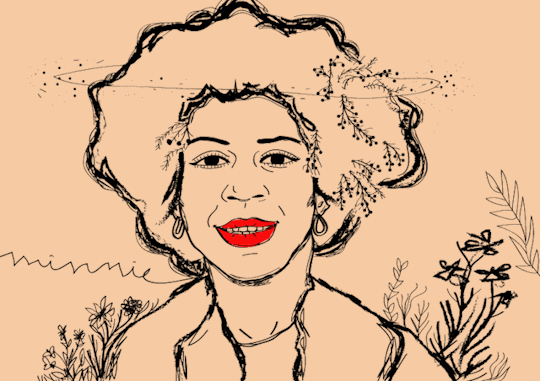

#african#afrakan#kemetic dreams#africans#afrakans#brown skin#brownskin#african culture#afrakan spirituality#riperton#tupac shakur#dr dre#a tribe called quest#the orb#minnie julia riperton#Minnie Julia Riperton Rudolph
239 notes
·
View notes
Text
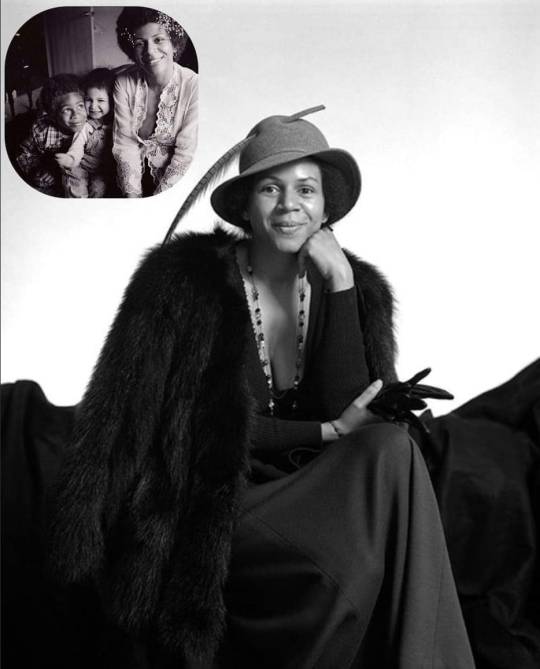
REMEMBERING MINNIE RIPERTON
Photograph of Minnie Riperton with her daughter actress Maya Rudolph and her son Marc Rudolph.
Minnie Julia Riperton Rudolph (November 8, 1947 – July 12, 1979) was an American singer-songwriter best known for her 1975 single "Lovin' You" and her four octave D3 to F♯7 coloratura soprano range. She is also widely known for her use of the whistle register and has been referred to by the media as the "Queen of the Whistle Register."
Minnie Riperton grew up in Chicago's Bronzeville neighborhood on the South Side. As a child, she studied music, drama and dance at Chicago's Lincoln Center. The youngest of eight children in a musical family, she embraced the arts early. Although she began with ballet and modern dance, her parents recognized her vocal and musical abilities and encouraged her to pursue music and voice. At Chicago's Abraham Lincoln Center, she received operatic vocal training from Marion Jeffery. She practiced breathing and phrasing, with particular emphasis on diction. Jeffery also trained Riperton to use her full range. While studying under Jeffery, she sang operettas and show tunes, in preparation for a career in opera. Jeffery was so convinced of her pupil's abilities that she strongly pushed her to further study the classics at Chicago's Junior Lyric Opera.
The young Riperton was, however, becoming interested in soul, rhythm and blues, and rock. In her teen years, she sang lead vocals for the Chicago-based girl group the Gems. Eventually the group became a session group known as Studio Three and it was during this period that they provided the backing vocals on the classic 1965 Fontella Bass hit "Rescue Me".
After graduating from Hyde Park High School (now Hyde Park Academy High School), she enrolled at Loop College and became a member of Zeta Phi Beta sorority. She dropped out of college to pursue her music career.
Her early affiliation with the legendary Chicago-based Chess Records afforded her the opportunity to sing backup for various established artists such as Etta James, Fontella Bass, Ramsey Lewis, Bo Diddley, Chuck Berry and Muddy Waters. While at Chess, Riperton also sang lead for the experimental rock/soul group Rotary Connection, from 1967 to 1971.
On April 5, 1975, Riperton reached the apex of her career with her No. 1 single "Lovin' You". The single was the last release from her 1974 gold album titled Perfect Angel. Riperton's third album, Adventures in Paradise was released in 1975. Despite the R&B hit "Inside My Love", some radio stations refused to play "Inside My Love" due to the lyrics.
Her fourth album for Epic Records, titled Stay in Love (1977), featured another collaboration with Stevie Wonder in the funky disco tune "Stick Together".
In 1978, Richard Rudolph and Riperton's attorney Mike Rosenfeld orchestrated a move to Capitol Records for Riperton and her CBS Records catalog. In April 1979, Riperton released her fifth and final album, Minnie. "Memory Lane" was a hit from the album.
Riperton provided backing vocals on Stevie Wonder's songs "Creepin'" from 1974's Fulfillingness' First Finale and "Ordinary Pain" from 1976's Songs in the Key of Life. In 1977, she lent her vocal abilities to a track named "Yesterday and Karma", on Osamu Kitajima's album, Osamu.
In January 1976, Riperton was diagnosed with breast cancer and, in April, she underwent a radical mastectomy. By the time of diagnosis, the cancer had metastasized and she was given about six months to live. Despite the grim prognosis, she continued recording and touring. She was one of the first celebrities to go public with her breast cancer diagnosis but did not disclose she was terminally ill.
In 1977, she became a spokesperson for the American Cancer Society. In 1978, she received the American Cancer Society's Courage Award, which was presented to her at the White House by President Jimmy Carter.
Riperton died of cancer on July 12, 1979 at the age 31.
During the 1990s, Riperton's music was sampled by many rap and hip-hop artists, including Tupac Shakur, Dr. Dre, A Tribe Called Quest, Blumentopf, The Orb and Tragedy Khadafi.
50 notes
·
View notes
Text
15/02/23 ~ NTS Radio - Yukihiro Takahashi Special
Presenting to you, the music of the late Yukihiro Takahashi - a leading figure in Japan’s music scene for nearly 50 years and a member of Yellow Magic Orchestra.
As a drummer and a vocalist who embraced music technology, he had a wide artistic range - from city pop and arty new wave to acoustic folk-rock, in addition to producing material for several pop acts and composing film and video game soundtracks.
Born in 1952 in Tokyo, he began his music career early, playing drums with college bands while still in junior high school and starting as a session musician at 16. He studied design at an Art University in Tokyo, without graduating. Like many of his peers, his artistic output had no limits - he developed his own clothing line in the 70s (Bricks), often designing the outfits worn by Yellow Magic Orchestra. He also took the role of actor in several films - mostly comedic roles (he seemed to have a good sense of humour!) & some of which, he produced soundtracks for.
Takahashi loved to collaborate, forming bands on the fly and bringing in friends to play on individual tracks.
So - I hope you enjoy this chronological deep dive into Yukihiro Takahashi’s musical catalogue as I pay tribute to his iconic and influential life. I’ve listened most of his 43 albums and have done my best to condense them into 2 hours! Let’s go!
1992 - Expected Ocean Umi Sora Sango no Iitsutae Soundtrack
Movie soundtrack by Takahashi acting as a bed for the show’s intro.
youtube
2. 1975 - Sadistic Mika Band - Time To Noodle - Hot! Music
Sadistic Mika Band were formed in 1972 - the founding member, Kazuhiko Katō moved to Kensington in 72 and was impressed by the upcoming glam rock scene led by T.Rex and David Bowie - so he formed the band in Japan, including his wife Mika and Takahashi on drums. The name is a parody of the 60s band, Plastic Ono Band.
The band were popular in the UK, touring with Roxy Music in ‘75 - the first ever UK tour by a Japanese band. During this period, they performed on the BBC’s Old Grey Whistle Test. When they appeared, the name of the programme (usually shown hung from the back wall) was spelt as The Old Gley Whistle Test as a nod to the Japanese pronunciation of the letters L and R.
Sadistic Mika Band’s albums were released on Doughnut Records - Japan’s first private label that was founded by Katō.
Around the time of Hot Music’s release, members of Yellow Magic Orchestra started working together on solo projects and as a part of each others bands.
3. 1978 - Sadistics - Nao - We Are Just Taking Off
Katō and Mika divorced and left the band. The remaining members, Takahashi, Takanaka, Imai, and Gotō continued for several years as The Sadistics. They released two albums and two live albums before the band eventually petered out in ’79 as the members became busy with their solo careers & other projects.
4. 1978 - Present - Sarravah!
This was Takahashi’s first solo album, created whilst on tenure from The Sadistics. It was produced by Sakamoto - he also features on keys. Plus Hosono on bass, with Tatsuro Yamashita, Minako Yoshida & Rajie on backing vocals.
Named after Pierre Barouh’s record label of the same name, Takahasi based the album on French pop music - this influence would later show up in early YMO material.
Sarravah! Was released the same year that YMO fully formed, recorded & released first album.
5. 1980 - Numbers From A Calculated Conversation - Murdered by the Music
Second studio album & his first release whilst he was a member of YMO. Murdered by the Music did pretty well in the Japanese charts, reaching #12.
Features contributions from Sakamoto, Hosono & Sandii.
6. 1981 - Extra Ordinary - Neuromantic
This is my favourite album from Takahashi’s collection - synth-pop goodness and his vocals are perfection!
Neuromantic was self-produced, again with contributions from Sakamoto and Hosono + Tony Mansfield and members of Roxy Music.
The name, Neuromantic, is a pun on the early 1980s British fashion movement, the New Romantics.
youtube
7. 1981 - Drip Dry Eyes - Neuromantic
Another classic from Neuromantic. My favourite song of his, probably yours too. Was also covered by Sandii. & the video! Ah!
8. 1981 - The Beatniks- No Way Out - Exitentialism
Formed by Takahashi & Keiichi Suzuki in 1981. More of an Alt-rock tinge. They released several albums, including soundtracks for Yohji Yamamoto’s catwalk shows.
Their first album in 7 years was released in 2018. That same year, they performed live in several concerts, despite Takahashi’s recent eye surgery.
9. 1982 - Flashback - What Me, Worry?
Fourth solo album. More features from Sakamoto & Hososno + Zaine Griff, Tony Mansfield, and Bill Nelson.
Takahashi’s first release on YEN Records - An imprint of Alfa Records that ran from 1982 to 1985 fronted by Hosono and Takahashi, releasing music from Sandii, Hajime Tachibana, Miharu Koshi & more. They also produced most of the albums.

10. 1983 - Kagero (Live Version from Time & Place) - Tomorrow’s Just Another Day
This album reached 11 in the music charts - the highest ranking for Takahashi’s solo work! Tomorrow’s Just Another Day really emphasises Takahashi as a singer.
This version, taken from Time & Place was recorded live at Shibuya Kokaido in Tokyo, Aug. 1983.
+ peep the cute cover!
11. 1983 - And I Believe In You - Are You Receiving Me?
Had to include this one as it’s another favourite. Released as the B Side to the single, Are you Receiving Me? This is classic Takahashi synth-pop goodness <3
12. 1984 - Walking to the Beat - Wild and Moody
Sixth and last solo album on his YEN label.
Wild and Moody is quite mellow. He sings mostly in English, hoping to pursue more of a global audience. The lyrics for Track 2 were written by Steve Jansen who was a close collaborator of Takahashi and Jansen considered him as a mentor.
youtube
13. 1985 - Instrumental - Poisson d'Avril
Soundtrack from the comedy film "Poisson D'avril" (April's Fool in French), released in 1986. Takahashi plays the lead role!
14. 1985 - I Saw The Light - Once A Fool
Another fav and it’s a Todd Rundgren cover. It’s just perfect pop.
Once A Fool was the first album from the T.E.N.T. label that was started by Takahashi and Keiichi Suzuki (of the Beatniks). With Sakamoto on keys and synths, Hosono on bass & synths & Hiroshi Sato on the organ. + backing vocals from Miharu Koshi!
15. 1986 - Moonlight Feels Right - Only When I Laugh
Second release on T.E.N.T. Only When I Laugh feels quite fresh with more of an acoustic tinge to it.
16. 1987 - Parfum De L'Aube - La Pensee
Music for Yohji Yamamoto’s S/S ‘87 + A/W ‘87 - ‘88 collection, shown in Paris.
Takahashi & Yamamoto often collaborated, and YMO often wore Yamamoto’s designs on tour. In 1991 Takahashi & Hosono walked the runway for Yamamoto and Comme des Garçons legendary collection “6.1 the men”
17. 1987 - Main Theme - Ginga No Sannin OST
Takahashi composed a lot of music for video games, and his work in YMO had a major influence on early video game music.
18. 1988 - Sea Change - Ego
Features some of his bolder synth arrangements and arena-ready tracks, with contributions from Sakamoto.
19. 1992 - mis - Life Time Happy Time
Another classic pop album from Takahashi - this one flew under the radar a bit and doesn’t stand out from his collection as much as others.
20. 1995 - Fate of Gold - Fate of Gold
Takahashi wanted to collaborate with a wide variety of artists of all different ages, “with the attitude of: "I'll let you mature when you're mature” “ Featuring Skapara, KYON, Rei Ohara, ICE's MAYUMI and Takenaka Naoto.
21. 1997 - Pulse - The Choice - Pulse
In September 1997 Steve Jansen and Takahashi formed UK based, Pulse and completed a 6 track album in Tokyo and London under the same name. Released on Yukihiro's own label, Consipio Records.
A very experimental, more “contemporary” album! The Choice features vocals from Indian classical singer Sonia Mehta.
22. 1999 - For Men - The Dearest Fool
Takahashi returns to the 80s techno-pop sound! + another collaboration with Steve Jansen.
23. 2002 - Sketch Show - Gokigen Ikaga 1 2 3 - Audio Sponge
After YMO decided to “spread out” (they didn’t want to say “split-up”), Takahashi and Hosono formed Sketch Show. Sketch Show had ore of an electronica output as opposed to pop.
Sakamoto often joined Sketch Show performances and recording sessions. He later proposed they rename the group Human Audio Sponge (or HAS) when he participates.
Sketch Show played live shows at Japanese raves and a headline slot at the 2003 edition of SONAR in Barcelona.
24. 2008 - Pupa - Jargon - What’s Pupa - Floating Pupa
Takhashi put together Pupa in 2007 - formed of Tomoyo Harada, Hiroshi Takada, Ren Takada, Hirohisa Horie, and Tomohiko Gondo. The band name Pupa is a term from fly-fishing, a sport that Takahashi loves.
25. 2013 - Shadow - Life Anew
Aged 61 - Takahashi goes back to basics yet you can tell he’s feeling musically inspired with Life Anew, which sounds more like a rock band than anything else he’s put out before.
Features contributions from former Smashing Pumpkins member, James Iha.
26. 2014 - Yukihiro Takahashi & Metafive - Drip Dry Eyes (Live) - Techno Recital
Takahashi originally assembled Keigo Oyamada, Yoshinori Sunahara, Towa Tei, Tomohiko Gondo, and Leo Imai to serve as the backing band (billed as Yukihiro Takahashi & Metafive) on his 2014 tour - this version of Drip Dry Eyes was taken from the Roppongi Theatre show, for which they were billed as Yukihiro Takahashi & Metafive. In 2015, the band changed their name to Metafive.
They disbanded after the release of their last album, METAATEM in 2021, after the release was originally cancelled due to controversy from Oyamama’s past history of bullying.
The line-up of Imai, Sunahara, Nagai and Shirane changed their name to TESTSET and released their debut EP in 2022.
youtube
27. 1998 - Stay Close (Live) - Once A Fool
We end on another favourite - a joyous live version from 1998 of Stay Close. - another collaboration with Steve Jansen.
Thank you Yuki-san for everything you’ve given the world - your legacy will live on forever <3
34 notes
·
View notes
Text
Rubell Museum - DC - Jan 13 2024
A trip to the Rubell Museum was something to look forward to despite my new Doc Martens slicing up my ankles during my 10-minute walk from the Waterfront Metro station. Opened on Oct 29th, 2022, the DC location at 65 I St. SW brought Mera and Don Rubell's collection of post-1980 art from Miami to the DC's Southwest neighborhood. This would be my second time visiting with my first experience viewing the inaugural exhibition What's Going On?. The collection showcased many artists I was not familiar with. It was a treat discovering new and exciting art. For me, artists that I wanted to learn more about from my last visit were Chase Hall, Hernan Bas and Christina Quarles.

Christina Quarles
Detail: Fell to Earth (Felt to Pieces), 2018
Acrylic on Canvas
Taking advantage of the gorgeous and expansive space past the entrance, the museum mounted works by Alexandre Diop - a Franco-Senegalese artist who, according to the website, "uses discarded objects to create work that raises questions pertaining to sociopolitical, cultural and gender issues. Drawing inspiration from his European and African roots, he explores the legacies of colonialism and diaspora while tackling universal themes of ancestry, suffering, and historical violence". The open space with its large cathedral-esque windows floods the space with natural light, showcasing all the wonderful varied textures and highlighting all the materials that Diop uses in his work.

Once you exit this room, you will enter a three-level building that was once part of Randall Junior High School, a historically Black public school that ceased operations in 1978. The Rubells purchased this historic site from the Corcoran College of Art and Design in 2010 for $6.5 million. The building was the site for the inaugural What's Going On? when the museum opened in 2022.
Although quite disorienting to navigate at first, each level essentially follows a radial floor plan. There will be an exhibit in the middle of the level when you first come, and then out in all directions are hallways that will lead to individual rooms with their own exhibits relating to the overall current exhibition - Singular Views: 25 Artists.
One of the biggest flaws in the architecture of the building or more importantly, how the architecture is utilized, is the decision to install art in the narrow hallways. These hallways doubtfully will pass the modern fire and safety code. Large enough to fit one individual through, there would often be two-dimensional works hanging on both sides of the wall. The proximity between the visitors and the works would make any conservator nervous. There is a serious bottleneck where a visitor must wait for another to pass through before entering these spaces. Needless to say, when there is a person waiting, one cannot help but exit in a hurried manner. This takes away any chance for close looking or truly connecting and appreciating the work.
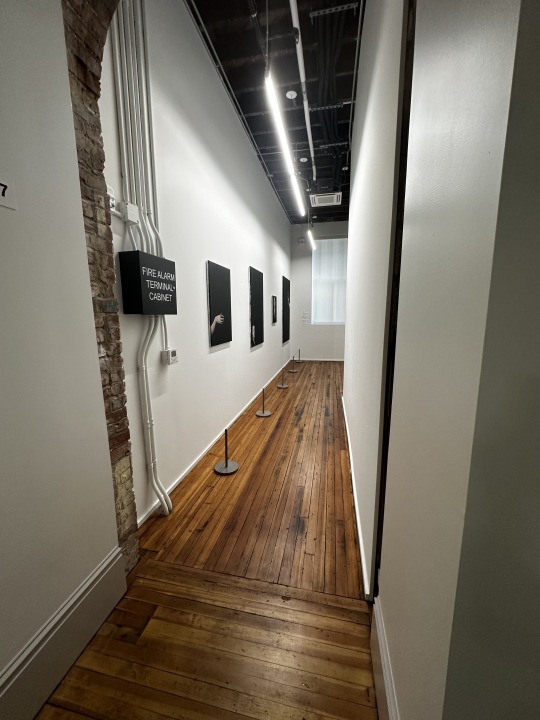
Overall, the exhibition was something you would come to expect of the Rubell Museum (so far that I have seen in DC): colorful, vibrant, electric and featuring young artists, some in their early or mid careers. The standouts this time for me were Amoako Boafo, Otis Kwame Kye Quaicoe and Rozeal, whom I will be covering in separate posts so they each have their own spotlights.
2 notes
·
View notes
Note
M!A: 70s/high-school Rin and Len. (I just wanna see more interactions between Rin len fukase Mayu and the others.) For 10 asks.

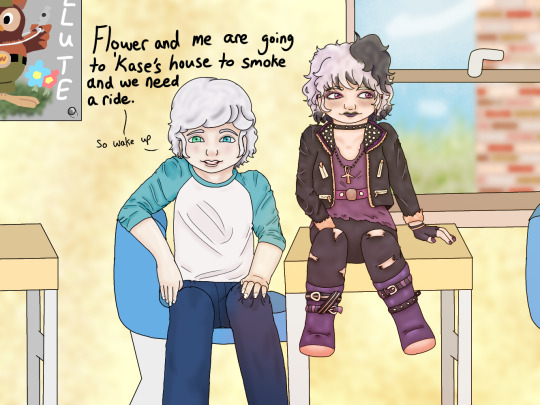
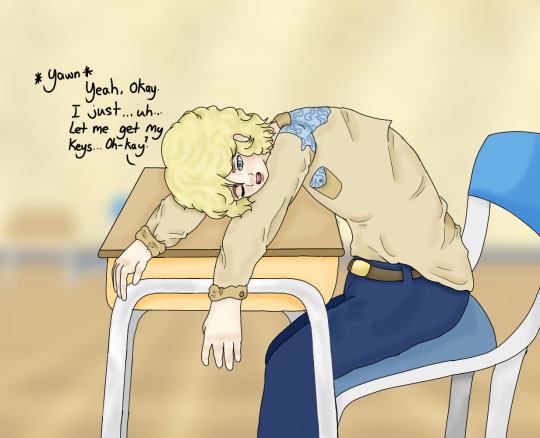
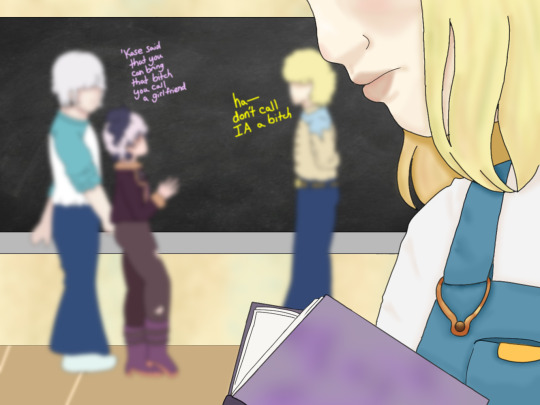
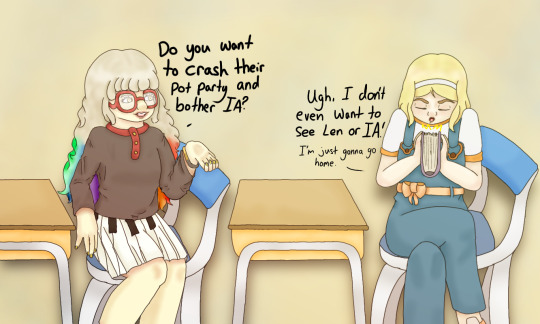
M!A: Junior Year 1978
Ages are as follow:
Fukase: 17
Rin(Riliane), Len, IA, Piko: 16
Mayu, Flower: 15
Oliver: 14
(There is a possibility of trigger warnings if I go into depth with this M!A so I'll put them up as needed)
4 notes
·
View notes
Text
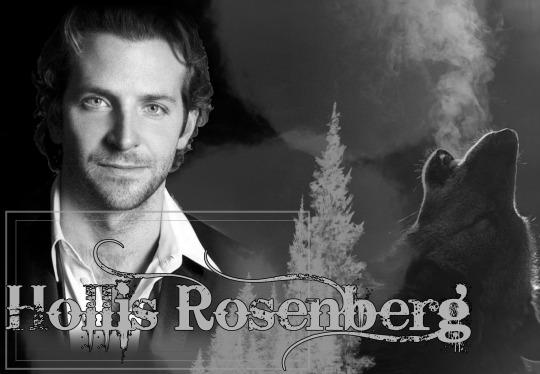
𝕙𝕠𝕝𝕝𝕚𝕤 𝕣𝕠𝕤𝕖𝕟𝕓𝕖𝕣𝕘
he was born forty-five years ago, he is a werewolf and lives in wolf crossing as a medical malpractice lawyer, and is in the pack. he looks an awful lot like bradley cooper.
"I never wanted you to see the darkest part of me."
tw: gore, blood, death
Emma and Phillip Rosenberg never really planned on having children so when the couple found out that they were pregnant, they weren’t exactly excited. Never the less, they saw the pregnancy through and on Janaury 5, 1978, Hollis Paul Rosenberg was born. The whole thing had been rough for the couple and Emma had awful case of postpartum depression on top of it. The couple managed to muster through the turmoil and raised their son as best as they could. Being an only child, Hollis was often yearning for the attention of his parents, particularly his father. His father was rarely home and when he was, he really wanted nothing to do with his son or even his wife. He would usually just hole himself up in the study and drink until the sun went down.
Hollis was a very imaginative child. He was always creating extravagant tales and acting them out with the kids on his block. He was always the main creator in their games of make believe. Every day, he would have a new idea. At school, the teachers were all very fond of Hollis and his consistently positive attitude. There was no questioning that he was the brightest one in his class every year. He could come home from school with positive marks every day and still, his father didn’t care. When Hollis turned ten, he stopped yearning for the attention since he realized that he would never get it.
When he was twelve years old, his parents got divorced and his mother got custody of him, which was fine with him. Sure, he wasn’t that close with his mother either but she at least would speak to him and try to care. A few years later, the boy got his first job busing tables at a local diner. It wasn’t much money but it was at least something to give his mother a hand with some of the costs of being a single mother.
By his junior year in high school, Hollis knew that it was his ultimate goal to be a lawyer and once he graduated, he started working towards that goal. He took a break after high school to just work and gather money up so that he could attend the school of his dreams: Stanford, which he did get accepted into. He just couldn’t afford it, even with the scholarships he was given. After about 5 years of strictly saving money, Hollis was content with his situation, reapplied and started up his schooling with Stanford. While in law school, Hollis had friends but no one that he could really call a best friend. That was until he met Brian Hayes. He was a bartender at a local bar and the two immediately hit it off. The guy was different from everyone else at Stanford and Hollis liked that. It was nice to have a change of pace from the pompous soon to be lawyers.
Things were going quite well for Hollis at school and he was almost ready to start really studying for his bar exam. As a way to help clear Hollis’ mind for a bit, Brian asked if he wanted to go on a camping trip with some of his friends. There was no way that Hollis was going to miss that. It was bound to be a good time.
And it was.
Until they got attacked.
Werewolves were a thing that you saw in the movies and read about in some preteen novels but never in a million years would Hollis ever expect them to exist. But it was obvious that they were for they were right in front of his eyes, ripping apart his friends one by one. Rather than wanting to suffer the same fate, he grabbed a hold of Brian and ran off as fast as he possibly could, wanting to make some serious distance between them and the beasts.
Hollis thought that he had successfully escaped the werewolves and he stood there with his best friend wondering just what in the hell they should do. There wasn’t much time for thinking though. The next thing he knew, he was telling Brian to run and a lycan was jumping out from behind the trees, attacking Hollis. Strong claws ripped from his neck down to his chest and strong teeth ripper deeply into his thigh, leaving the man in a heap on the ground, choking on his own blood. There was no doubt in his mind that he was going to die there.
Somehow, some way, he lived though. Hollis woke up in a hospital bed a few days later and could barely remember what had happened…until he brought his hand up to his neck and felt the bandage there. His hand moved to his thigh and he felt the deep gash there as well. Memories flew back to him and immediately, he began to thrash around in his bed, questioning the staff about his best friend. He could by the look on their faces that it wasn’t good. They told him that he was the only found alive and that it was a miracle that he was alive. But Hollis didn’t care. His best friend was dead.
After he was released from the hospital, he refused to leave his apartment until he could figure out just what was going to happen to him. He did as much research as he could online but there wasn’t much on it besides what the books said. Hollis was going to find out what would happen to a lycan first hand. Sure there was a chance that he didn’t get the curse, at least from what online said, but he wasn’t that lucky. The night of the full moon, the man locked himself in the bathroom and went through the first of many transformations.
The next morning, there wasn’t much that Hollis remembered. Except pain. There was so much pain. He could remember feeling his bones crack and his muscles ripping… Pushing those thoughts from his mind, he groggily pushed himself up from the floor and looked around the bathroom, noticing how completely fucked it was. Not to mention that he was completely nude too. There was not one thing left in tact in that room. And it was beginning to flood since the wolf had, apparently, pulled the toilet of the wall, causing the leak. There was no doubt the people downstairs were going to be pissed.
Hollis didn’t quite know where to go from there. He was alone, scared and confused. What exactly was his life now? What did being a werewolf entail? Even thinking about being one was just…weird. Hollis didn’t like how he felt. It was very unsettling to him. It constantly felt like there was something else pacing around in his mind. Was it always going to be like this?
When he felt fine enough with what he currently was, and took his bar exam, Hollis moved back to Greywood, the place that he would always call home. Except now, he was a big shot lawyer with a touch of werewolf. Hollis is currently working on opening his own law firm and doing his best to pretend that he wasn't a ravenous, bloodthirsty animal every 30 days or so.
"what power did he attain when settling in greywood?”
Hollis gained the power of blindsense. He does not need to see a person to know where they are when they are within a certain distance to him. He assumed it had to do with his werewolf senses, but he has come to realize it's more than just that.
penned by... Sam
#supernatural rp#town rp#oc rp#mature rp#literate rp#horror rp#bradley cooper fc#werewolf#blood tw#death tw#gore tw#retired
2 notes
·
View notes
Text
“That a certain segment of the internet would be so hungry for even a fleeting glimpse of Malick is not surprising. The director is as famous for his closely guarded privacy as his output. He has not given an on-the-record interview in nearly four decades. From 1978, when Paramount released Malick’s second film, the Panhandle-set Days of Heaven, until 1998, when his World War II epic, The Thin Red Line, premiered, Malick more or less vanished. Rumors circulated around Hollywood that he was living in a garage, that he was teaching philosophy at the Sorbonne, that he was working as a hairdresser. Even as he returned to filmmaking, was nominated for Oscars, won the Cannes Film Festival’s Palm d’Or, and doubled down on his experimental style (cinephiles will never stop debating his decision to punctuate a fifties Texas family drama with CGI dinosaurs in The Tree of Life), Malick continued to maintain his silence.
(…)
Malick was born in Illinois in 1943 and spent his boyhood mostly in Waco and Bartlesville, Oklahoma, the eldest of three brothers. His mother, Irene, was a homemaker who had grown up on a farm near Chicago; his father, Emil, was the son of Assyrian Christians from Urmia, in what is now modern-day Iran, and staked out a career as an executive with the Phillips Petroleum Company. Emil was aggressively accomplished, a multi-patent-holding geologist who played professional-level church organ and served as a choir director, and he pushed the young Malick to succeed on all fronts from an early age. (A Waco Tribune-Herald news brief from 1952 noted that “eight-year-old Terry” had “surprised his classmates at Lake Waco Elementary School by presenting a 43-page paper on planets.”) But Emil could be a stern taskmaster, and he and Malick often butted heads. “They had some conflicts over the years,” Jim Lynch, a close friend of Malick’s since high school, told me. “That’s one reason Terry came to St. Stephen’s.”
St. Stephen’s is known as the Hill, both for its steep topography and its aspiration to be an enlightened beacon (as in the biblical “city on a hill”), and Malick thrived in a culture that emphasized spirituality, intellectualism, and rugged individualism. “When I first got there, it was made known that he was the local genius,” Lynch told me. Malick had the highest standing in the class his junior and senior years, served in student leadership positions like dorm council, played forward on the basketball team, and, with Romberg, co-captained the football team, playing both offensive and defensive tackle, an accomplishment of which he’s still proud. (“He says that in football he was ‘the sixty-minute man,’ ” Linklater told me. “Ecky says that the only time he boasts is when he talks about his high school athletic prowess.”)
None of Malick’s peers—or, it would seem, Malick—had any inkling that he would stake out a career as a filmmaker, but he was already exploring many of the ideas that would animate his work. Students at St. Stephen’s went to chapel twice a day, and the spiritual education there was both rigorous and open-minded, with The Catcher in the Rye taught alongside more traditional religious texts in the school’s Christian ethics class. “It was religious in a broad humanities sense,” Lynch said, a conception that Malick embraced. “Terry doesn’t like anything sectarian or dogmatic,” Lynch added. “His grounding is more in a philosophical sense of wonder.”
(…)
After Harvard and a Rhodes Scholarship at Oxford University, Malick began experimenting with more-white-collar careers. He worked for a short time as a globe-trotting magazine journalist, interviewing Haitian dictator “Papa Doc” Duvalier and spending four months in Bolivia reporting for the New Yorker on the trial of the French philosopher Régis Debray, who had been accused of supporting Che Guevara and his Marxist revolutionary forces. (Malick never completed the piece.) Then there was a year as a philosophy lecturer at the Massachusetts Institute of Technology, during which Malick concluded that he “didn’t have the sort of edge” required to be a good teacher. And finally, he moved to Hollywood, where he studied at the American Film Institute and quickly became an in-demand screenwriter, working on an early version of Dirty Harry, writing the script for the forgotten Paul Newman–Lee Marvin western Pocket Money, and making powerful friends like Bonnie and Clyde director Arthur Penn and AFI founder George Stevens Jr.
But Malick wanted to make his own film, and he found a story he wanted to tell in the late-fifties murder spree of Charles Starkweather. Though Malick had never directed a feature, he insisted on total freedom and had few qualms about scrapping the production schedule when he became inspired to shoot a different scene or location, exasperating many in the crew. But when Badlands, starring Martin Sheen and Sissy Spacek, opened at the New York Film Festival in 1973, Malick became an instant sensation. The New York Times critic Vincent Canby called it a “cool, sometimes brilliant, always ferociously American film” and wrote that the 29-year-old Malick had “immense talent.” (The Times also reported that getting Malick to talk about Badlands was “about as easy as getting Garbo to gab.”)
Soon, Malick began production on his follow-up, Days of Heaven, a tragic love story starring Richard Gere, Sam Shepard, and Brooke Adams set in the North Texas wheat fields where Malick had worked after high school. Badlands hadn’t been an easy shoot, but on Days of Heaven, Malick’s unorthodox approach had the crew on the brink of mutiny, and when the film finally came out, in 1978, the reviews were decidedly mixed, sometimes within the same review. “It is full of elegant and striking photography; and it is an intolerably artsy, artificial film,” wrote Harold C. Schonberg in the New York Times.
Days of Heaven won an Academy Award for best cinematography, and it is now widely regarded as a masterpiece. (Roger Ebert, delighting in the stunning magic-hour photography and the poetic tone, would judge it “one of the most beautiful films ever made.”) But the experience of making the film had been so grueling for Malick that, according to Badlands producer Ed Pressman, “he just didn’t want to direct anymore.” The year after Days of Heaven premiered, Malick abandoned production on his next project, a wildly ambitious movie called Qasida that he’d hoped would tell the story of the evolution of Earth and the cosmos, and informed friends and colleagues that he was relocating full-time to Paris.
(…)
There is only one publicly available recording of Malick’s voice. Around halfway through Badlands, he makes the single on-screen cameo of his career, engaging in a brief, tense exchange with Kit Carruthers, the Charles Starkweather–like killer played by Martin Sheen. Malick speaks in a slow, soft, higher-pitched drawl. He is unfailingly polite, a little retiring, and warm without being chummy. Malick has one of those voices that lends itself to imitation—broad and regional and distinctive—and when I spoke with his friends and colleagues, I heard several versions of it. They all sounded like the Malick we see in Badlands.
Malick’s friends describe him as a generous and humble man with a capacious intellect and a child’s insatiable curiosity. He likes going deep on birding, cosmological events, and the interconnectedness of the natural world. (“You’ll be talking to him about butterflies in the Barton Creek watershed, and then he’ll start talking about the soil and all the soil insects,” said filmmaker Laura Dunn.) He enjoys discussing the fundamental questions that drive religious and philosophical inquiry and has a deep knowledge of the Bible. (Lynch remembers that after seeing Mel Gibson’s The Passion of the Christ, Malick—a fluent French speaker, with conversational German and Spanish—mentioned that he understood the film’s spoken Aramaic, because he’d grown up hearing it from his paternal grandparents.) And yet, as in high school, Malick can be just as down-to-earth as high-minded. He’ll show up for lunch at an unfussy cafe wearing a bright Hawaiian shirt and talk about football or gush about pop-culture schlock like the genetically-modified-shark movie Deep Blue Sea or drop a quote from Ben Stiller’s Zoolander. (After hearing that Malick was a fan, Stiller made an in-character happy-birthday video for the director.)
(…)
Malick is even more buttoned-up about his work. He politely shrugs off compliments about his films—which, in the old Hollywood style, he calls “pictures”—seemingly agonizing over flaws, missed opportunities, and bad memories of the production. “I’ll mention something like, ‘Hey, I heard there were some seventy-millimeter prints of Days of Heaven. And he’ll say, ‘Oh, gosh, when that opened, I was out of the country,’ ” Linklater said. “I think talking about his work takes him back emotionally.”
Laura Dunn, whom Malick recruited to direct The Unforeseen, a documentary about Austin’s development boom and the pollution of Barton Springs, told me that Malick finds it difficult to watch movies from start to finish. “He’s the kind of artist who seems almost tormented by his need to keep working on something,” she said. “If he’s sitting in a dark room, watching a movie all the way through, he’s restless because he’ll still be editing one of his own movies, or he’ll think about all the things he did that he regrets and wants to go back and change.”
(…)
Malick takes years to finish his films, hiring teams of editors to put together different cuts, and finding and discarding entire story lines during the post-production process. In the final cut of The Tree of Life, Malick resolves the drama at the center of the film by having his young protagonist’s family move away from his boyhood home. There’s a bittersweet sense of a chapter closing and an uncertain future lying ahead. But in an earlier, unreleased version of the film, the story of the protagonist, Jack, ends not with his family’s departure from Waco but on a more triumphant note: he arrives as a boarding student at St. Stephen’s. It doesn’t take a deep familiarity with Malick’s life story to see the parallels between the family in the film and Malick’s own. Jack bridles under the discipline of his stern, accomplished, and ultimately loving father. He worships his angelic mother. He and his two younger brothers turn to each other for support. The film is framed around the premature death of the middle brother. (Malick’s brother Larry took his own life as a young man.)
(…)
Malick’s silence has always seemed, in part, a way to resist such a reading. When Lynch mentioned to Malick that he saw the director’s last three features—The Tree of Life, To the Wonder, and Knight of Cups—as an “autobiographical trilogy,” Malick took umbrage. “He didn’t like me labeling them that way,” Lynch said. “He didn’t want people thinking that he was just making movies about himself. He was making movies about broader issues.” Malick might very well say the same of Song to Song, but nevertheless, it’s tempting to see his latest work as an extension of that discarded Tree of Life ending—the aging director offering a raucous love letter to the city that offered him inspiration as a boy and has sustained him ever since.”
7 notes
·
View notes
Text
Meet The Characters:
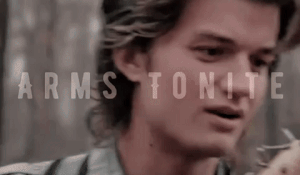
fanfic: Arms Tonite
fandom: Stranger Things
pairing(s): Steve Harrington x Fem!OC Eddie Munson x Male!OC
authors note: When reading this please, please don’t hesitate to give feedback!! These characters are far from done when it comes to development and just overall creation!!! If you have any little quirks that you think would fit or any fun story lines you think I should add, let me know!!!

Natalie Dixon is a junior at Hawkins High school and a close friend of two time senior, Eddie Munson. She’s long since been known for her loud mouth and ‘devil-may-care’ attitude, but after the events of November of 1983, the frigid wall she’d built around her heart seems to be melting. And Steve Harrington is no help when it comes to keeping up her tough girl persona.
Her father, RJ Dixon, is a known felon. Wanted for various misdemeanors and larger crimes such as drug trafficking around the nation. Spending more time in prison than in Natalies life, she found a father figure in Wayne Munson, her mother’s sort-of boyfriend. Katie Dixon tried her best to be there for her daughter, but between picking up extra shifts at the local diner and working nights as a dancer in one of Indianapolis’ various dive bars, her parenting duties have been put on the back burner. Natalie has long since resorted to raising herself and keeping the people around her (save Eddie and Wayne Munson) at arms length. But again, Steve Harrington and his newly acquired nice guy charm, have been making it extremely difficult for her to do so.
Quote(s):
“Men are never right. That’s why women were created, to think for you assholes.”
“I am so not high enough for this conversation, Steve.”
“Just-I think I might-... I just want you to stay, okay?”
Theme song(s):
The Only Heart Breaker by Mitski
O.D.D. by Hey Violet
Fluorescent Adolescent by the Arctic Monkeys
Matilda by Harry Styles
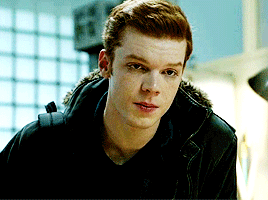
Jeremy Mayfield went from being sort-of openly gay in California, to being completely closeted when he moves to Hawkins. Transferring during your senior year is never ideal, but in Jeremy’s case it’s even worse considering he has his shitty step-father and his even shitter step-brother to deal with. Although, his younger sister Max, who could be argued to be his only friend, makes it slightly more bearable.
Only when Max gets mixed up in the drama of the Upside Down, Jeremy has no other option but to stay by her side in order to keep her safe. But in doing so he finds a friend in Natalie Dixon, Hawkins’ resident burnout, who just so happens to be the best friend — maybe girlfriend? — of the hottest man Jason has ever laid eyes on; Eddie Munson.
Quote(s):
“Okay, so this is the part in the horror movie where the audience starts screaming ‘no don’t do that’.”
“I wonder if my life will ever be normal again.”
“How do you know if a guy you’ve been hanging out with likes you?”
Theme song(s):
Family Line by Conan Gray
Achilles Come Down by Gang of Youths
Downhill by Lincoln

Jordan Gomez, former lab experiment gone-horribly-wrong, has been on the run since escaping Hawkins National Laboratory in the early summer of 1978. From the cops, from the ‘bad men’, from literal ghosts. You name it, it was probably chasing her and she was definitely running from it.
It’s only when her past comes barreling back into her life in the form of a telekinetic teenage girl, that she decides it’s finally time to stop running. However, upon returning to the town where she died — literally — she’s faced with more ghosts than she can handle. And not just the physical variety that she’s become acquainted with. Except, unlike the times before where she’d fled the scene faster than a speeding ticket, this time she has something she’s willing to fight for; a family.
Quote(s):
“I hate to break it to you, but talking to dead people isn’t exactly an effective offense.”
“I would rather slam my tongue in a car door everyday for the rest of my life, than ever have to converse with Mike again.”
“You know, I always wanted an older sister to terrorize.”
“It seems you people respond best to displays of violence.”
Theme song(s):
Rat by Penelope Scott
Dog Days Are Over by Florence + The Machine
Running Up That Hill (A Deal With God) by Kate Bush
Cigarette Daydreams by Cage The Elephant

From the moment Eddie Munson watched Natalie Dixon punch a boy in the face for staring at her ass, he knew that she was going to be his best friend. From learning how to play D&D, to starting a band and preforming at the middle school talent show. They did everything together. It got to the point where their peers started assuming they were dating; the freaks flocking together. It made sense, but the rumors were far from true. Other than a singular kiss during his freshman year, which resulted in the conclusion that Eddie did not like girls, their relationship was strictly platonic — Atleast they knew it was.
To hide Eddies inherent queerness from the population of Hawkins, the friends simply leaned into the dating rumors. Strategic hand holding in the hallways, the occasional hug as they parted ways. Considering that Eddie was putting off dating until after he escaped their dead-end town, their plan couldn’t fail... At least that was until Jason Mayfield moved to Hawkins.
Quote(s):
“I mean, I can't blame you, King Steve does have magnificent hair. Just don't you dare go dark-side on me for him, Nat.”
“Man, you gotta stop saying shit that makes me wanna kiss you.”
Theme song(s):
Line Without A Hook by Ricky Montgomery
18 by Anarbor
Good Old-Fashioned Lover Boy by Queen
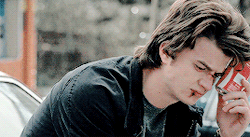
Steve Harrington had always assumed that Natalie Dixon was exactly what people had said she was; a burnout freak destined for prison or a career in stripping — just like her parents. Up until November of 1983, he’d never even bothered to look at her twice. It wasn’t until he’d barged back into the Byers residence in an attempt to save the love of his life, that his opinion on her finally changed. That he finally saw her.
She stood tall, weaponless before the demogorgon, in an attempt to protect Nancy and Jonathan. Selfless. It was the first word he’d learned to describe the new version of Natalie he’d acquainted himself with. Stupid, was another. It was downright idiotic to go against an inter dimensional monster without anything to protect yourself, and he didn’t shy away from telling her so. But, even after the dust had settled and their Mitch-matched monster hunting group was dispersed and disbanded, he found himself needing to know more; to find more words to describe Natalie Dixon. And he was determined to do just that, no matter how much she tried to push him away, he was going to know her.
Quote(s):
“You’re an idiot, you know that? You could’ve gotten yourself killed!”
“No-no, okay? Nat is so not my type. She’s eighteen and she still plays your little fantasy game. She’s a nerd. And she smokes. I don’t like how much she smokes. And her dads like a felon, okay? I don’t need to get mixed up in that shit. Besides, I’m like 90% sure she’s dating that freak, Eddie Munson.”
“We make a pretty good team, Dixon...”
Theme song(s):
Disaster by Conan Gray
Love of My Life by Harry Styles
Gold Rush by Taylor Swift
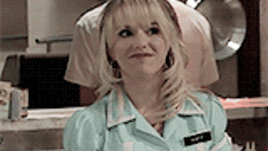
Katie Dixon, formerly Katie Wilson, fell down the same path that all high school prom queens eventually do. At the ripe age of seventeen she, inevitably, fell for the ‘bad boy’ of Hawkins High School. And just like every other love story, it all ended with a faulty condom. In the spring of her senior year, Katie Wilson discovered she was pregnant with none other than RJ Dixon’s baby. Caught up in the moment, the couple married a month before their daughters birth (against Katie’s older sister, Karen’s, wishes).
Just like he was always destined too, RJ left only a year after their daughters birth. Without the help of her parents, who’d disowned her the moment she’d decided against having an abortion, she turned to her older sister, Karen. The mother-daughter duo lived with the Wheelers for nearly a year before Katie had been able to save up enough for a small trailer in Forest Hills Trailer Park. It was than that she rekindled her high school friendship with Wayne Munson who, conveniently enough, owned a trailer just across from her own. But even after years of flirting and practically taking in Wayne’s nephew, Eddie, as her own, Katie Dixon would always be hung up on her daughters father.
Quote(s):
“For a woman, life is a battle, and beauty is a goddamn machine gun.”
“Sweetie, I’ve seen the way that boy looks at you. Like you hung the goddamn moon.”
theme song(s):
Nothing New by Taylor Swift
Easy on Me by Adele
The Lucky One by Taylor Swift
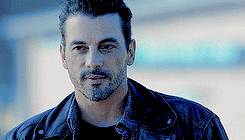
RJ Dixon didn’t know how not to be a fuck up. Being raised by a deadbeat father of his own drastically effected his ability to parent. So, instead of sticking around and hurting either Natalie or Katie, like he knew he inevitably would, he left in hopes of sparing them the pain that his own father had caused for him and his mother.
They say, old habits die hard, and in RJ’s case, they most certainly do. Still involved with the same gang his father once led and still hooked on the same drugs he’d spent his high schools years wallowing in, RJ hadn’t changed a single bit. He wasn’t capable of it. His life was like clockwork: carry out tasks for his gang, get caught, go to prison, land right back in Katie Dixon’s trailer swearing that he’d “be better this time” only to flee within the month. But what he’d never tell a soul, was that the times he spent with his daughter (even if, recently, they’d been spent with her hating him) were some of the brightest times in his life. And maybe, just maybe, Natalie was the reason he kept getting himself thrown in prison, just so he could spend his parole being a part of her life.
Quote(s):
“Listen, I know, I was gone for awhile but I’m here now!”
“This Harrington kid... is he treatin’ you right?”
Theme song(s):
Mockingbird by Eminem
#stranger things fanfiction#multiple pairings#gay eddie munson#cameron monaghan#sophie thatcher#skeet ulrich#steve harrington x fem!reader#wattpad#original character#meet my ocs
28 notes
·
View notes
Text
Then in 1973 two New York City policemen, Ulysses Williams and Lauren Walker's father David A. Walker, established Double Dutch as a team sport and got it into schools. When the first tournament was held a year later, nearly 600 kids participated. Many more were inspired.
Adrienne "Nikki" Adams Howell, Delores Brown Finlayson, De'Shone Adams Goodson, and Robin Oakes Watterson met as junior high schoolers on the Lower East Side in 1978. Howell says they meshed immediately. "Everyone had their own creative ideas and everyone had their own different strengths, you know, everything came together for us."
6 notes
·
View notes
Photo

THE STASH DAUBER
RANTS OF AN UNRECONSTRUCTED MUSIC GEEK
WEDNESDAY, JANUARY 12, 2022
https://stashdauber.blogspot.com/2022/01/the-nervebreakers-face-up-to-reality.html
The Nervebreakers' "Face Up to Reality"
[This time it's personal. My second most anticipated release of the millennium (after the Peter Laughner box) is here. I'm not going to review it, because I wrote the liner notes, which are reproduced in full below, including the part that wouldn't fit on the jacket. To say these guys are important to me would be an understatement. If my drummer from college hadn't seen them open for the Sex Pistols, I might not have moved from New York to Texas. Between 1978 and 1981, I saw them more times than any other band besides the Juke Jumpers. Mike Haskins remains my guitar hero, and Barry Kooda my human being hero. Bob Childress once surprised me with a message on the RadioShack corporate net after I'd written something about them online. My wife and I once made a pilgrimage to Austin to see Tex Edwards play a bar gig. And I'm proud to say that Carl Giesecke once played sleighbells on "I Wanna Be Your Dog" with Stoogeaphilia. But enough about me. I've got to go listen to this again.
]Think of this record as a follow-up that took a while to emerge.
It was 1980, 40 years ago as I write this, when the Nervebreakers -- who’d bossed the nascent Dallas punk scene from its inception, opened for every punk/”new wave” touring act that passed through Big D (Ramones, Sex Pistols, Clash, Police, Boomtown Rats), and made the pages of Rolling Stone via the image of guitarist Barry Kooda with a fish in his mouth onstage at the Pistols show – recorded their sole long player, We Want Everything!, which then took 14 years to make it onto vinyl.
The Nervebreakers coalesced in 1975 when Kooda, a junior college theater major back from Army service in Korea, managed to insinuate himself into the “arty rock band” Mr. Nervous Breakdown, formed by his high school best friend, guitarist Mike Haskins, with fellow record store employee Thom “Tex” Edwards. Haskins and Edwards bonded over their mutual appreciation for the Raspberries’ combination of tuneful songcraft and rock crunch. Drummer Carl Giesecke was a moonlighting symphony percussionist, while bassist Bob Childress, who’d joined after the Ramones show, held the distinction of having seen both the Stooges and the New York Dolls every night for a week at Richard’s in Atlanta while attending Georgia Tech.
Onstage, they had a formidable presence, honed over years of four-set gigs, with frontman Edwards draped rakishly over the mic stand, Kooda in his Army helmet and pistol belt, Haskins looking like Donnie Osmond’s axe-slinging twin, Childress bouncing around like the Uberfan who got to join his favorite band, and Giesecke pounding out a solid pulse. Their repertoire included covers as diverse as We Five’s “You Were On My Mind,” George Jones’ “The Race Is On,” and the Troggs’ “Strange Movies.” More to the point, they penned potent originals: “Hijack the Radio,” “Girls Girls Girls Girls Girls,” “My Girlfriend Is a Rock.” Haskins and Edwards were the main writers, with occasional contributions from Kooda, but drummer Giesecke claims credit for their best known song.
When the sessions for We Want Everything! were complete, Haskins and Childress left to form Bag O’ Wire, while the Nervebreakers recruited replacements for an East Coast tour, after which the band folded. Edwards and Kooda followed different musical directions, while Giesecke toured with Roky Erickson (whom the Nervebreakers had backed in 1979).
Fast forward to 2008, when the Nervebreakers reconvened in Haskins’ home studio to record some songs they’d never gotten around to documenting back when. The energy and excitement of the band in its heyday were still in ample supply, along with tunefulness, crunch, and sardonic wit. Highlights include the title track’s snaky rifferama, the leg-twitching rockabilly of “Just Yawn,” the splenetic snarl of “Don’t Wanna Be Used,” and the sprightly punk-country of “I Don’t Wanna Hold Your Hand.” Kooda penned the ennui anthem “Wake Me Up,” and co-wrote the dance-craze theme “They Were Doing the Pogo.” The closing triptych of “It’s Obvious,” “Breaking Down,” and “I’d Rather Die” provides a rousing conclusion to a rockin’ set of tunes that’s long overdue, but right on time.
POSTED BY STASHDAUBER AT 1:30 PM
4 notes
·
View notes
Text
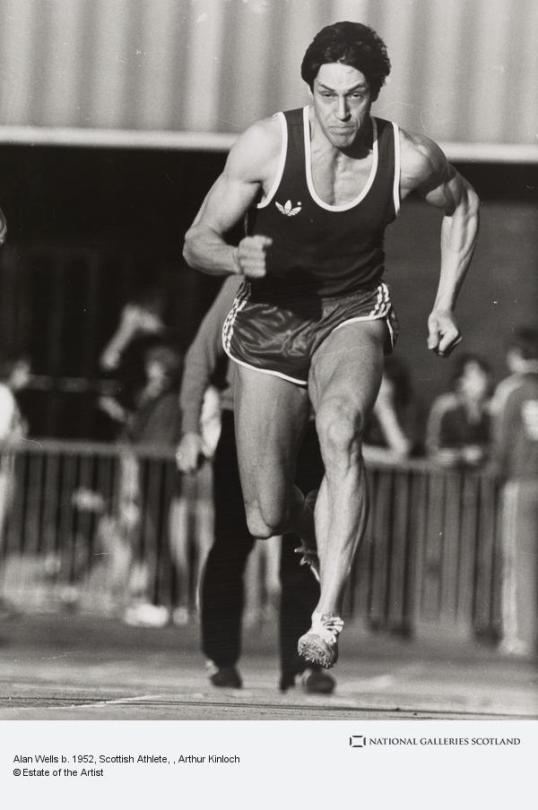



Happy birthday to Olympic gold medallist, Allan Wells, born May 3rd 1952 in Edinburgh.
Allan was schooled at Fernieside Primary School and then Liberton High School. He left school at age 15 to begin an engineering apprenticeship. The teenager was active in athletics from a young age and was initially a triple jumper and long jumper. In his first season of athletics in 1970, he won the Scottish junior triple jump title.
He took a break from athletics for a few years while he focused on his training as a marine engineer. He returned to athletics at the relatively late age of 24 yet proceeded to become one of the finest European athletes of his era. He won two golds at the 1978 Commonwealth Games but his biggest success was at the Summer Olympics in 1980 when he clinched the gold in the 100m.
There is a brilliant quote from Wells when he was asked after the victory if he had run the race for Harold Abrahams, the last 100 metre Olympic winner from Britain who had died two years previously, Wells replied, "No, ... I would prefer to dedicate this to Eric Liddell".
Allan also won a silver in the 200 metres in Moscow.
Following the Moscow Olympics, there was some suggestion that Wells's gold medal had been devalued by the boycott of the games. Wells accepted an invitation to take on the best USA sprinters of the day, among others, at a track meeting in Koblenz in Germany. Less than two weeks after the Moscow gold, Wells won the final that included Americans.
He went on to beat the Americans again in meetings in 1981, including the fastest 100 metres of that year which had been set by Carl Lewis.
Wells holds the prestigious position of being Scottish Athletics’ most successful athlete, in the Commonwealth games, winning four gold, one silver and one bronze for Scotland over two Commonwealth Games. He topped the Scottish all-time list of top Games athletes across all sports until the Gold Coast 2018 Games when lawn bowler Alex Marshall claimed top sport by winning his fifth Commonwealth Games gold, but it's hardly in the same league as athletics. Liz McColgan is Scotland’s top female athlete with two gold and a bronze from two Games.
On retiring from sprinting Wells went on to coach the Olympic Bobsleigh team.
In June 2015, a BBC documentary, Panorama: Catch Me If You Can,uncovered allegations by Wells' former teammate of historical doping by the 1980 Olympic 100m champion, beginning in 1977, he forcefully denies the allegations.
6 notes
·
View notes
Text
The Impact of Horror in My Life
by Dakota M.
Finding comfort in the items around oneself is rather common. Some individuals have blankets, songs, stuffed animals, toys, and etc. Even I myself have an orange fat tabby cat stuffed animal named Pumpkin. I could possibly always listen to music, but it did not bring me as much comfort as other forms of entertainment. Toys? Sure, as a kid, I remember having these My Little Pet Shop animals that I loved. Blankets? Absolutely, I love the comfort of a soft blanket. However, nothing comforted me more than the genre of Horror.
Horror a genre of jump scares, suspense, and gore. Yet even as a little girl I found comfort in all three of those staples of the genre. The creepy has always given me a sense of self. I remember the times I would wake up early around the Halloween season to watch Goosebumps by R.L. Stine on Cartoon Network from Elementary school into Junior High. The main title song rings a sense of nostalgia deep inside. A sense of home reached for me out of the pages of Scary Stories to Tell in the Dark by Alvin Schwartz. I found this home within the collected stories over the decades.
I could place memories of watching Killer Klowns from Outerspace with my Dad and Nana at the Holiday Twin Drive-In located in Fort Collins, CO. Always going the concession stand grabbing popcorn, drinks, and some candy. We also brought a meal from KFC so that we ate dinner while waiting for the sky to go dark. At this exact drive-in I have watched: Beetlejuice, War of the Worlds, Zombieland, The Addams Family, The Night of the Living Dead, Halloween, and more. This has been constant in my life, and a thing I take pride in even.
In high school I wrote reports on many horror-based subjects. For psychology it was about real serial killers, for art it was about capturing the horror in everyday photography, and for English it was all about writing my own stories for the genre. High school marked an era for my life where I began to cosplay. Creepy anime was big for me to cosplay at that point. Death Note, Soul Eater, and High School of the Dead. I got to see my comfort range across all forms of entertainment.
Getting into my adult years I began to cosplay from Resident Evil, Halloween 1978, Scream 1996, The Bride of Chucky, Dead by Daylight, and many other titles. Core memories made with the horror genre, the spooky stories, ghost tales, and the macabre. I began watching horror shows as well. One held a special place in my heart though. I watched Stranger Things season 1 the day it first came out. Love at first dice roll, so to speak. Relatability for bullied and downtrodden, plus the music was a bop. At this point I was trying to do college work, work, and still find myself.
Finding myself came through events that shook my life. A little after a few of those events COVID-19 hit. I found myself losing my mind in the solitude of the lock down. No horror movies at the theaters with friends and family, no boardgames, no cosplay events, and almost no outside time. I spoke with my best friends, and we came up with an idea. I should stream on Twitch. WitchyBunBun was born. This felt like me.
WitchyBunBun a stream name for a horror fanatic, who also happens to be into magical practices perfect. The channel theme is two important things in my life: Stranger Things and Horror. My comfort in the horror genre, the macabre, the creepy, and some D&D 80s horror show got to shine for all. Horror not only was my childhood comfort, but it also became my everyday comfort. Becoming a part of my everyday life, and dreams for careers. I have made a name for myself from the memories I shared with my Nana and Dad.
#horror#WitchyBunBun#stranger things#80s#childhood#childhood nostalgia#blog#podiescast#halloween#horror movies#comfort#twitch#college student#macabre#memories
2 notes
·
View notes
Text

Liv Tyler
Cannes 1996
Contax RTSIII CarlZeiss Sonnar T* 180mm f/2,8
...At some point she turned around and showed me her profile "Is she ok?" she asked me with a touch of irony. I nodded. The picture was excellent. I could see it without seeing it... (there were no camera screens back then.. .)
Tyler was born Liv Rundgren on July 1, 1977, in New York City at Mount Sinai Hospital.She is the only daughter of Bebe Buell, a model, singer, and former Playboy Playmate (Miss November 1974), and Steven Tyler, the lead singer of Aerosmith. Her mother named her after Norwegian actress Liv Ullmann, after seeing Ullmann on the cover of the March 5, 1977, issue of TV Guide.
Her ancestry includes Italian (from her great-grandfather), German, Ukrainian, and English. Tyler has three half-siblings: Mia Tyler (born 1978), Chelsea Anna Tyler Foster (née Tallarico; born 1989), and Taj Monroe Tallarico (born 1991).Her maternal grandmother, Dorothea Johnson, founded the Protocol School of Washington.
From 1972 to 1979, Buell lived with rock musician Todd Rundgren. In 1976, Buell became pregnant from a brief relationship with Steven Tyler. She gave birth on July 1, 1977, naming the daughter Liv Rundgren and claiming that Todd Rundgren was the biological father because Tyler was in the middle of his well-documented drug excesses. Liv told People Magazine in 1992 that "Todd's my spiritual father. I love him". By then Rundgren and Buell had ended their romantic relationship but Rundgren nevertheless signed the birth certificate and acted as a father figure to Liv, including paying for her education.
At age 10 or 11, Liv met Steven Tyler and suspected he was her father when she observed a resemblance between her and Tyler's daughter Mia. When she asked her mother, the secret was revealed. The truth about Tyler's paternity did not become public until 1991, when she changed her surname from Rundgren to Tyler,but kept Rundgren as a middle name. Buell's stated reason for claiming that Rundgren was Liv's father was that Steven Tyler was too heavily addicted to drugs at the time of Liv's birth.[5] Since learning the truth about her paternity, Liv and Steven have developed a close relationship. They also have worked together professionally, once when she appeared in Aerosmith's music video for "Crazy" in 1993, and again when Aerosmith performed songs in the film Armageddon (1998), in which Liv starred. Tyler maintains a close relationship with Rundgren. "I'm so grateful to him, I have so much love for him. You know, when he holds me it feels like Daddy. And he's very protective and strong."
Tyler attended the Congressional Schools of Virginia, Breakwater School, and Waynflete School in Portland, Maine, before returning to New York City with her mother at age 12 She went to York Preparatory in New York City for junior high and high school after her mother researched the school to accommodate Tyler's ADHD. She also attended the Crossroads School for Arts & Sciences in Santa Monica, California. She graduated from York in 1995 and left to continue her acting career. When asked about her youth, Tyler said: "For me, I didn't get much of a childhood in my teen years because I've been working since I was 14. But that also kept me out of trouble. When everybody was doing acid and partying like crazy, I was at work on a movie in Tuscany ... having my own fun, of course, but it was a different kind of thing. I have no regrets. I love the way my life has gone."
#liv tyler#actress#american#famous#movies#model#star#producer#singer#analogue photography#black and white#analog camera#cinema#portrait
2 notes
·
View notes
Text
TW: homophobic parents, potential religious trauma, generally bad parenting
Alex Mercer headcanons:
· Both of his parents were born in Germany, and they came to the States after they got married.
· Born to Tomas and Petra in Los Angeles, California in 1978. His baby sister Julia was born in 1981.
· Alex’s parents were incredibly strict. They were heavily involved in the church, and cared more about appearances than their kids’ feelings (“but what will the neighbours think?” was heard frequently in the Mercer household).
· Alex was in piano lessons, which morphed into him playing the organ in church. He started drums at the suggestion of his youth pastor (who didn’t last very long, with all his “progressive” views, but he still managed to make a significant impact on Alex’s life). The Mercers were not overly thrilled with the suggestion of buying a drum set, but eventually caved when a few church elders expressed excitement over adding drums to their worship band.
· He was in band in middle school and all through high school, and learned an assortment of instruments. He played everything they had in the percussion section, but he also played trumpet and trombone.
· Alex took dance classes all through elementary school and loved absolutely all of them. His dad made him stop when he was 11 though, because it was too girly. His sister kept up with dance, and would teach him the moves in their basement (they also did Jane Fonda’s exercise video religiously after it came out, and as many other home dance workout routines as they could get their hands on).
· Alex was also very into water sports; he and Julia spent countless hours during summer vacation at the community pool, and the beach. He loved to swim, surf, snorkel, and scuba dive.
Scuba diving was one of the activities he could do with his whole family, since his parents were marine biologists and went diving pretty much all the time. Alex and Julia started taking the junior scuba diving classes as soon as they each turned 10.
2 notes
·
View notes
Text
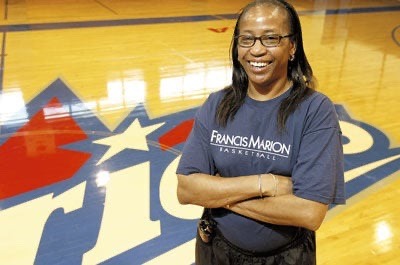
Pearl Moore (born March 16, 1957) is a basketball player who played for the Women’s Professional Basketball League. During her career at Francis Marion University, she had one of the most prolific scorers in college history, male or female, and is the all-time career-scoring leader in women’s college basketball. In 1979, she began her WBL career, playing with the New York Stars, the following season, she joined the St. Louis Streak. She played the final season of her professional career in Venezuela.
Born in Florence, South Carolina, at Wilson High School where she was in the starting line-up for all four years, earning the MVP award at the 1975 and 1976 AAU Junior Olympic Games. She commenced her collegiate career with Anderson Junior College for one semester, transferred to Francis Marion University, and, because of AIAW rules, she was eligible to play the remainder of the season.
She posted a single-game record of 60 points in a victory over Eastern Washington State College in the 1978 AIAW Small College National Tournament. She scored 42 points against the University of Tennessee at Chattanooga to break the previous record of 4,045 career points. She averaged 30.6 points per game during her stint at Francis Marion, scored a total of 4,061 points in an era where the three-point arc was not incorporated into women’s basketball, and helped lead the Patriots to three national championship appearances. She always scored in double-figures and posted fewer than 20 points in only 18 of her total 128 games. It remains the most points scored by any AIAW basketball player. After big-named schools moved to the NCAA in the early 1980s and a federal antitrust lawsuit, the AIAW dissolved, but their records never died.
She graduated from Francis Marion with a BS in Sociology.
She coached high school teams. She has received recognition for her accomplishments in women’s basketball with her induction into the FMU Athletic Hall of Fame and the Women’s Basketball Hall of Fame. She currently hosts her girls’ basketball camp. She was selected to be inducted into the Naismith Memorial Basketball Hall of Fame. #africanhistory365 #africanexcellence #womenshistorymonth
1 note
·
View note